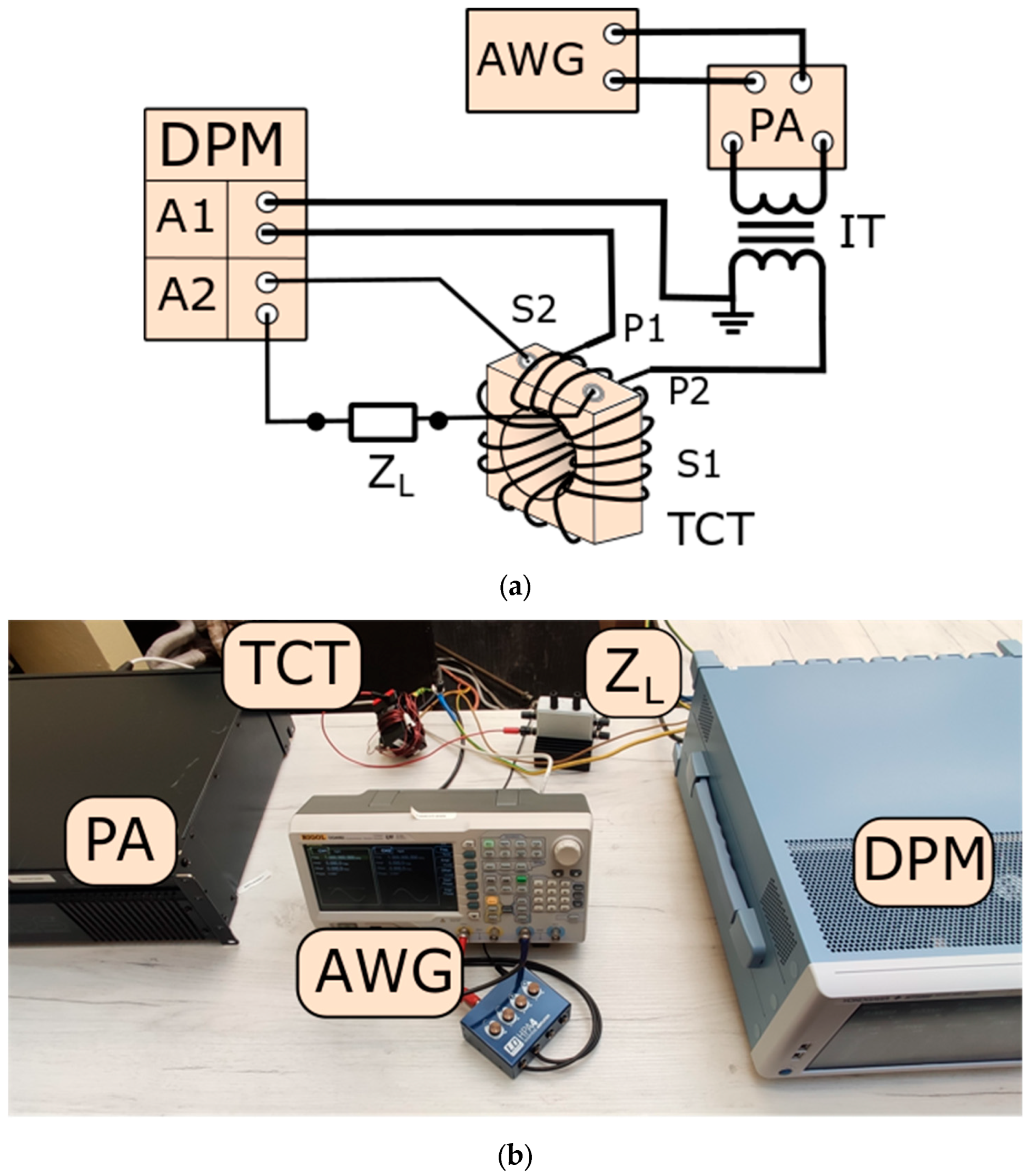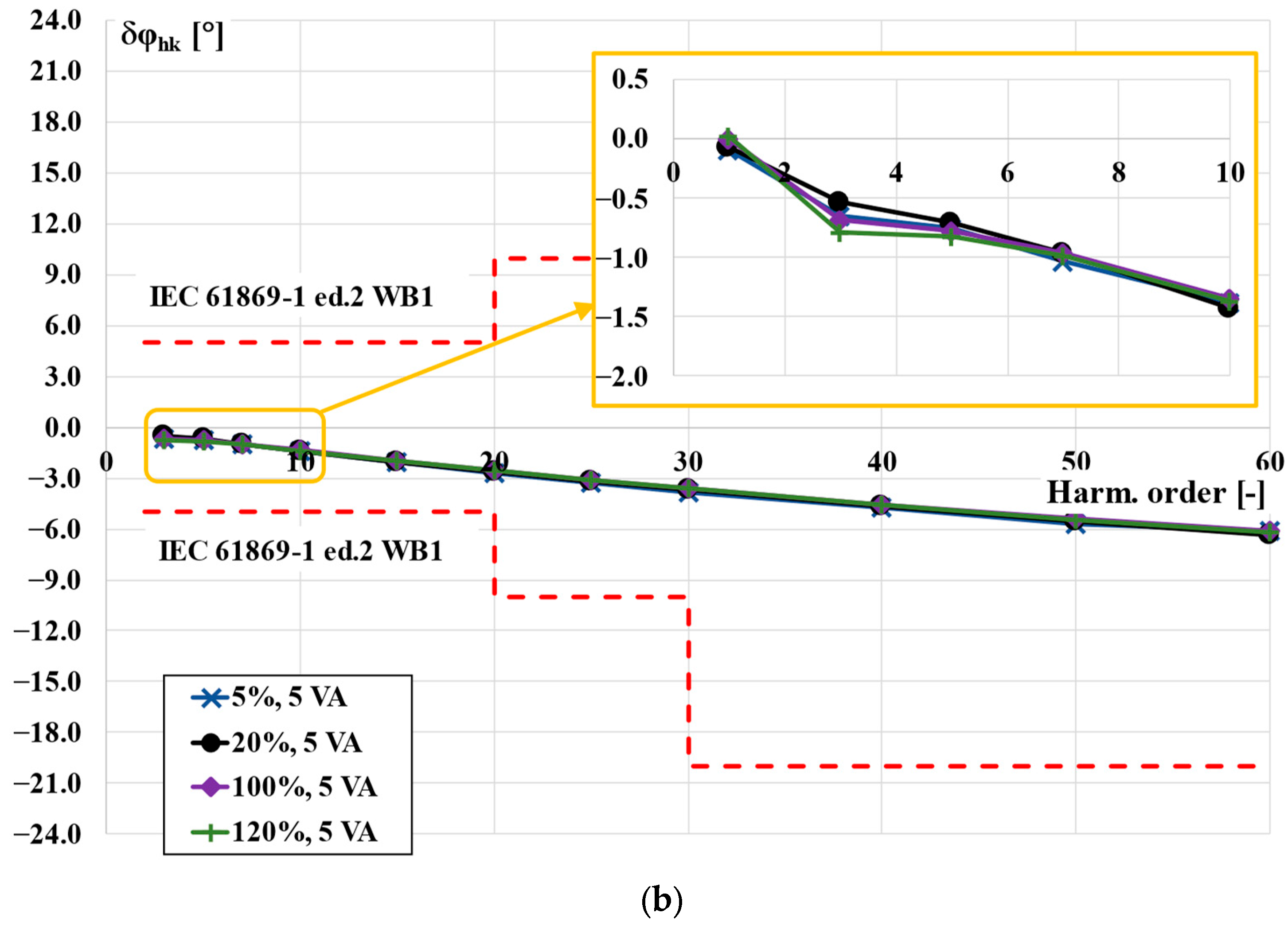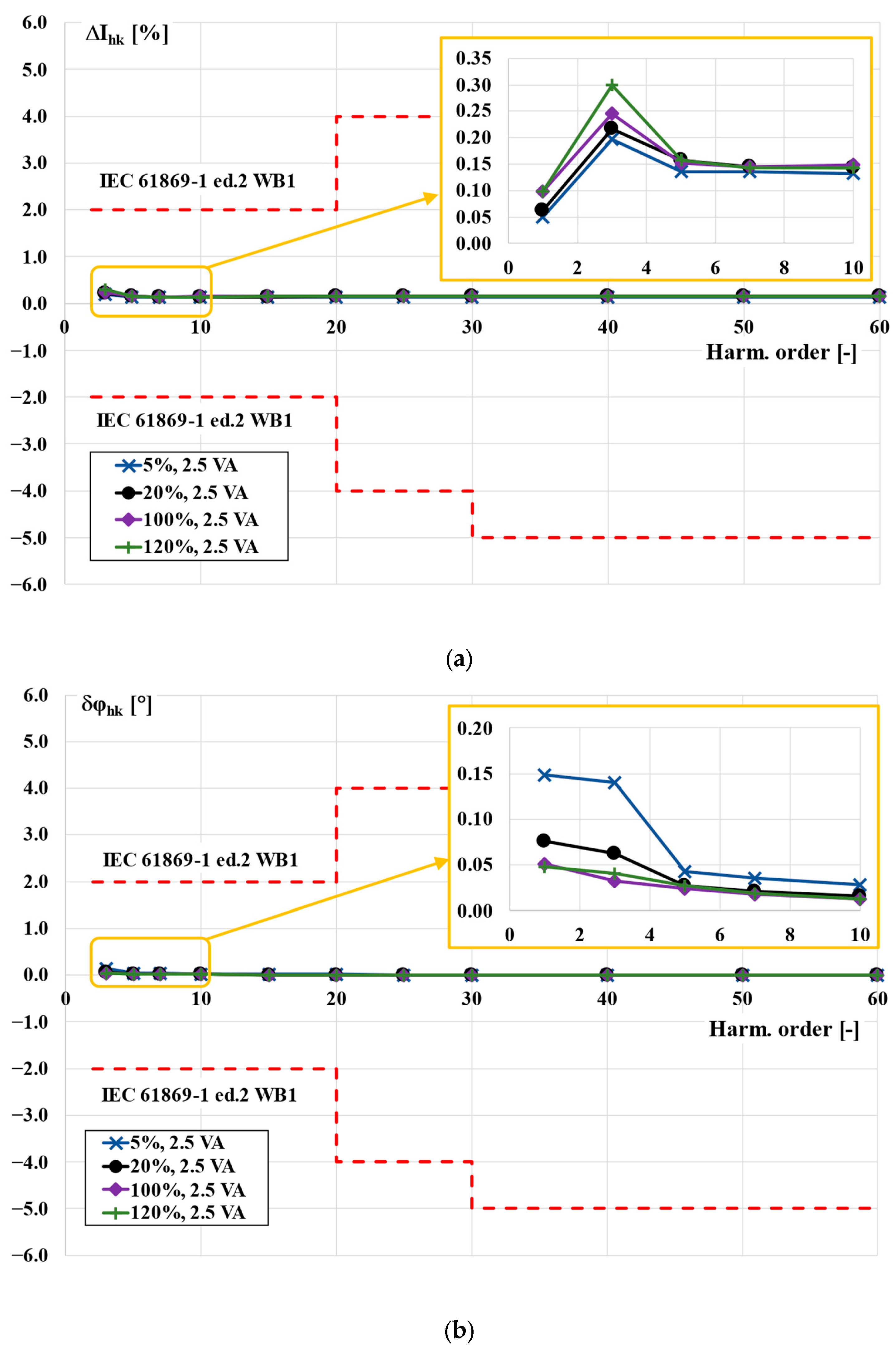Evaluation of the Optional Wideband Accuracy of Inductive Current Transformers in Accordance with the Standard IEC 61869-1 Ed.2
Abstract
:1. Introduction
- WB0—covering harmonics up to and including the 13th harmonic.
- WB1—encompassing harmonic frequencies up to and including 3 kHz.
- WB2—including harmonic frequencies up to 20 kHz.
- WB3—spanning harmonic frequencies up to 150 kHz.
- WB4—applicable for wide-bandwidth applications up to 500 kHz.
2. Measuring Circuits and Tested CTs
3. Wideband Accuracy of the TCTs
3.1. Results for TCT 300 A/5 A Class 0.5
3.2. Results for TCT 300 A/5 A Class 0.2
4. Conclusions
Author Contributions
Funding
Data Availability Statement
Conflicts of Interest
References
- Hossain, E.; Tur, M.R.; Padmanaban, S.; Ay, S.; Khan, I. Analysis and Mitigation of Power Quality Issues in Distributed Generation Systems Using Custom Power Devices. IEEE Access 2018, 6, 16816–16833. [Google Scholar] [CrossRef]
- Liang, X. Emerging Power Quality Challenges Due to Integration of Renewable Energy Sources. IEEE Trans. Ind. Appl. 2017, 53, 855–866. [Google Scholar] [CrossRef]
- Montoya, F.G.; Baños, R.; Alcayde, A.; Montoya, M.G.; Manzano-Agugliaro, F. Power quality: Scientific collaboration networks and research trends. Energies 2018, 11, 2067. [Google Scholar] [CrossRef]
- Dirik, H.; Duran, I.U.; Gezegin, C. A Computation and Metering Method for Harmonic Emissions of Individual Consumers. IEEE Trans. Instrum. Meas. 2019, 68, 412–420. [Google Scholar] [CrossRef]
- Stano, E.; Kaczmarek, P.; Kaczmarek, M. Why Should We Test the Wideband Transformation Accuracy of Inductive Current Transformers? Energies 2022, 15, 5737. [Google Scholar] [CrossRef]
- Mingotti, A.; Peretto, L.; Tinarelli, R. Smart characterization of rogowski coils by using a synthetized signal. Sensors 2020, 20, 3359. [Google Scholar] [CrossRef]
- Mingotti, A.; Bartolomei, L.; Peretto, L.; Tinarelli, R. On the long-period accuracy behavior of inductive and low-power instrument transformers. Sensors 2020, 20, 5810. [Google Scholar] [CrossRef]
- Murray, R.; De Kock, J. Instrument transformers influence on harmonic measurements for grid code compliance. In Proceedings of the 2018 IEEE 4th Global Electromagnetic Compatibility Conference, GEMCCon, Stellenbosch, South Africa, 7–9 November 2018; IEEE: New York, NY, USA, 2019. [Google Scholar]
- Mingotti, A.; Peretto, L.; Bartolomei, L.; Cavaliere, D.; Tinarelli, R. Are inductive current transformers performance really affected by actual distorted network conditions? An experimental case study. Sensors 2020, 20, 927. [Google Scholar] [CrossRef]
- Kaczmarek, M.; Stano, E. Challenges of Accurate Measurement of Distorted Current and Voltage in the Power Grid by Conventional Instrument Transformers. Energies 2023, 16, 2648. [Google Scholar] [CrossRef]
- Kaczmarek, M.; Stano, E. New Approach to Evaluate the Transformation Accuracy of Inductive CTs for Distorted Current. Energies 2023, 16, 3026. [Google Scholar] [CrossRef]
- Cataliotti, A.; Cosentino, V.; Crotti, G.; Giordano, D.; Modarres, M.; Di Cara, D.; Tinè, G.; Gallo, D.; Landi, C.; Luiso, M. Metrological performances of voltage and current instrument transformers in harmonics measurements. In Proceedings of the I2MTC 2018—2018 IEEE International Instrumentation and Measurement Technology Conference: Discovering New Horizons in Instrumentation and Measurement, Houston, TX, USA, 14–17 May 2018; pp. 1–6. [Google Scholar]
- Fritsch, M.; Wolter, M. High-Frequency Current Transformer Design and Construction Guide. IEEE Trans. Instrum. Meas. 2022, 71, 1–9. [Google Scholar] [CrossRef]
- Letizia, P.S.; Crotti, G.; Mingotti, A.; Tinarelli, R.; Chen, Y.; Mohns, E.; Agazar, M.; Istrate, D.; Ayhan, B.; Çayci, H.; et al. Characterization of Instrument Transformers under Realistic Conditions: Impact of Single and Combined Influence Quantities on Their Wideband Behavior. Sensors 2023, 23, 7833. [Google Scholar] [CrossRef] [PubMed]
- Mateev, V.; Ralchev, M.; Marinova, I. Current Sensor Accuracy Enhancement by Harmonic Spectrum Analysis. In Proceedings of the 2019 13th International Conference on Sensing Technology (ICST), Sydney, Australia, 2–4 December 2019; pp. 1–4. [Google Scholar]
- Ranasingh, S.; Pradhan, T.; Dhenuvakonda, K.R. Calibration and frequency estimation in sensors for electrical parameter measurement using regression and metaheuristic based models. Expert Syst. 2023, 40, e13208. [Google Scholar] [CrossRef]
- IEC 61869-1; Inst. transf.—General Requirements. 2nd ed. IEC: Geneva, Switzerland, 2023.
- IEC 61869-6; Inst. transf.—Additional General Requirements for Low-Power Instrument Transformers. IEC: Geneva, Switzerland, 2016.
- Stano, E.; Kaczmarek, M. Analytical method to determine the values of current error and phase displacement of inductive current transformers during transformation of distorted currents higher harmonics. Measurement 2022, 200, 111664. [Google Scholar] [CrossRef]
- Kaczmarek, M.; Kaczmarek, P.; Stano, E. The Effect of the Load Power Factor of the Inductive CT’s Secondary Winding on Its Distorted Current’s Harmonics Transformation Accuracy. Energies 2022, 15, 6258. [Google Scholar] [CrossRef]
- Yan, P.; Liu, G.; Wang, R.; Xia, B.; Zhang, J.; Yi, L. development method and comparative analysis of measurement accuracy of new broadband and wide range current transformers. In Proceedings of the 2022 4th International Conference on Electrical Engineering and Control Technologies (CEECT), Shanghai, China, 16–18 December 2022; pp. 379–384. [Google Scholar]
- Kaczmarek, M.; Stano, E. Measuring system for testing the transformation accuracy of harmonics of distorted voltage by medium voltage instrument transformers. Measurement 2021, 181, 109628. [Google Scholar] [CrossRef]
- IEC 61869-2:2012/ISH1:2022 ED1; Interpretation Sheet 1—Instrument Transformers—Part 2: Additional Requirements for Current Transformers. IEC: Geneva, Switzerland, 2022.
- Crotti, G.; Chen, Y.; Çayci, H.; D’Avanzo, G.; Landi, C.; Letizia, P.S.; Luiso, M.; Mohns, E.; Muñoz, F.; Styblikova, R.; et al. How Instrument Transformers Influence Power Quality Measurements: A Proposal of Accuracy Verification Tests. Sensors 2022, 22, 5847. [Google Scholar] [CrossRef]
- Haas, A.; Niitsoo, J.; Taklaja, P.; Palu, I. analysis of electricity meters under distorted load conditions. In Proceedings of the PQ 2012: 8th International Conference—2012 Electric Power Quality and Supply Reliability, Tartu, Estonia, 11–13 June 2012; pp. 281–284. [Google Scholar]
- Zobaa, A.F.; Abdel Aleem, S.H.E. A new approach for harmonic distortion minimization in power systems supplying nonlinear loads. IEEE Trans. Ind. Inform. 2014, 10, 1401–1412. [Google Scholar] [CrossRef]
- Sharma, H.; Rylander, M.; Dorr, D. Grid impacts due to increased penetration of newer harmonic sources. IEEE Trans. Ind. Appl. 2016, 52, 99–104. [Google Scholar] [CrossRef]
- Mazin, H.E.; Xu, W.; Huang, B. Determining the harmonic impacts of multiple harmonic-producing loads. IEEE Trans. Power Deliv. 2011, 26, 1187–1195. [Google Scholar] [CrossRef]
- Cataliotti, A.; Di Cara, D.; Emanuel, A.E.; Nuccio, S. Current transformers effects on the measurement of harmonic active power in LV and MV networks. IEEE Trans. Power Deliv. 2011, 26, 360–368. [Google Scholar] [CrossRef]
- Vieira, D.; Shayani, R.A.; De Oliveira, M.A.G. Reactive Power Billing under Nonsinusoidal Conditions for Low-Voltage Systems. IEEE Trans. Instrum. Meas. 2017, 66, 2004–2011. [Google Scholar] [CrossRef]
- Lin, F.; Liang, B.; Shao, H.; Wang, H. Development of Wide-band Current Transformer for Precision Measurement of High-Current. In Proceedings of the 2020 Conference on Precision Electromagnetic Measurements (CPEM), Denver, CO, USA, 24–28 August 2020; pp. 20–21. [Google Scholar] [CrossRef]
- Takahashi, K.; Yamawaki, M.; Tadokoro, T. Current ratio transfer standard and improved equivalent ampere turn method. IEEE Trans. Instrum. Meas. 2013, 62, 1716–1722. [Google Scholar] [CrossRef]
- IEC 61869-2; Ins. Transf.—Additional Requirements for Current Transformers. IEC: Geneva, Switzerland, 2012.







| Percentage of the Rated Current | Limit | Rated Load | 25% of Load | |||
|---|---|---|---|---|---|---|
| ΔI [%] | δφ [°] | ΔI [%] | δφ [°] | ΔI [%] | δφ [°] | |
| 5 | ±1.5 | ±1.5 | −1.13 | −0.09 | −0.17 | 0.27 |
| 20 | ±0.75 | ±0.75 | −0.74 | −0.07 | 0.01 | 0.23 |
| 100 | ±0.5 | ±0.5 | −0.49 | 0.00 | 0.16 | 0.15 |
| 120 | ±0.5 | ±0.5 | −0.40 | 0.02 | 0.18 | 0.13 |
| Percentage of the Rated Current | Limit | Rated Load | 25% of Load | |||
|---|---|---|---|---|---|---|
| ΔI [%] | δφ [°] | ΔI [%] | δφ [°] | ΔI [%] | δφ [°] | |
| 5 | ±0.75 | ±0.5 | 0.05 | 0.15 | 0.12 | 0.11 |
| 20 | ±0.35 | ±0.25 | 0.06 | 0.08 | 0.12 | 0.06 |
| 100 | ±0.2 | ±0.17 | 0.10 | 0.05 | 0.15 | 0.04 |
| 120 | ±0.2 | ±0.17 | 0.10 | 0.05 | 0.15 | 0.04 |
Disclaimer/Publisher’s Note: The statements, opinions and data contained in all publications are solely those of the individual author(s) and contributor(s) and not of MDPI and/or the editor(s). MDPI and/or the editor(s) disclaim responsibility for any injury to people or property resulting from any ideas, methods, instructions or products referred to in the content. |
© 2023 by the authors. Licensee MDPI, Basel, Switzerland. This article is an open access article distributed under the terms and conditions of the Creative Commons Attribution (CC BY) license (https://creativecommons.org/licenses/by/4.0/).
Share and Cite
Stano, E.; Kaczmarek, P.; Kaczmarek, M. Evaluation of the Optional Wideband Accuracy of Inductive Current Transformers in Accordance with the Standard IEC 61869-1 Ed.2. Energies 2023, 16, 7206. https://doi.org/10.3390/en16207206
Stano E, Kaczmarek P, Kaczmarek M. Evaluation of the Optional Wideband Accuracy of Inductive Current Transformers in Accordance with the Standard IEC 61869-1 Ed.2. Energies. 2023; 16(20):7206. https://doi.org/10.3390/en16207206
Chicago/Turabian StyleStano, Ernest, Piotr Kaczmarek, and Michal Kaczmarek. 2023. "Evaluation of the Optional Wideband Accuracy of Inductive Current Transformers in Accordance with the Standard IEC 61869-1 Ed.2" Energies 16, no. 20: 7206. https://doi.org/10.3390/en16207206
APA StyleStano, E., Kaczmarek, P., & Kaczmarek, M. (2023). Evaluation of the Optional Wideband Accuracy of Inductive Current Transformers in Accordance with the Standard IEC 61869-1 Ed.2. Energies, 16(20), 7206. https://doi.org/10.3390/en16207206







